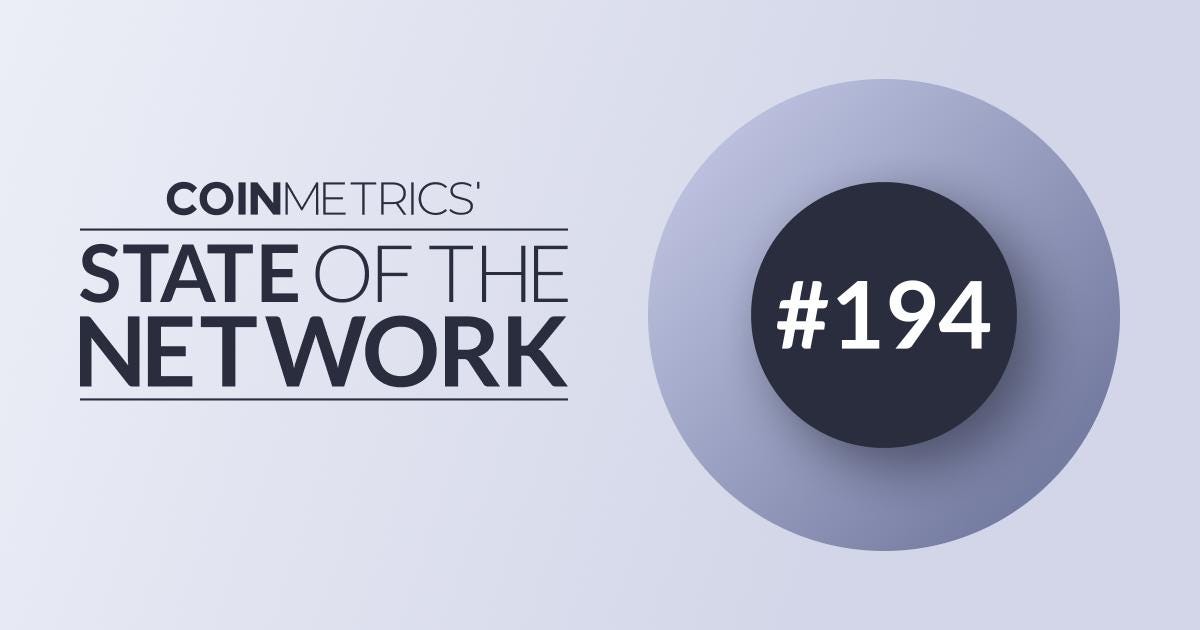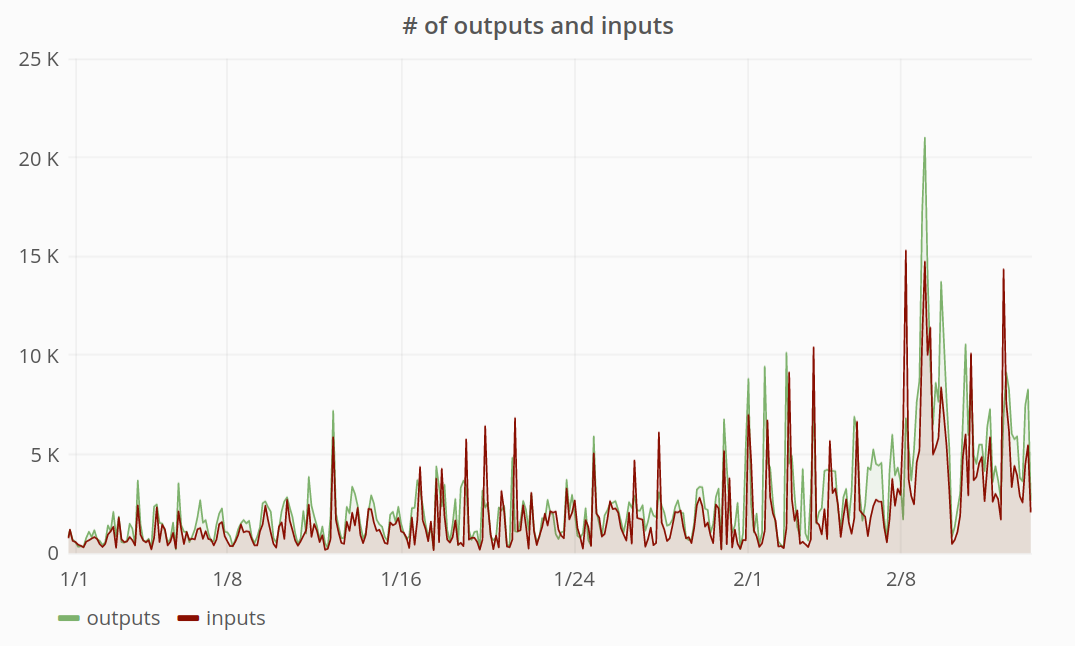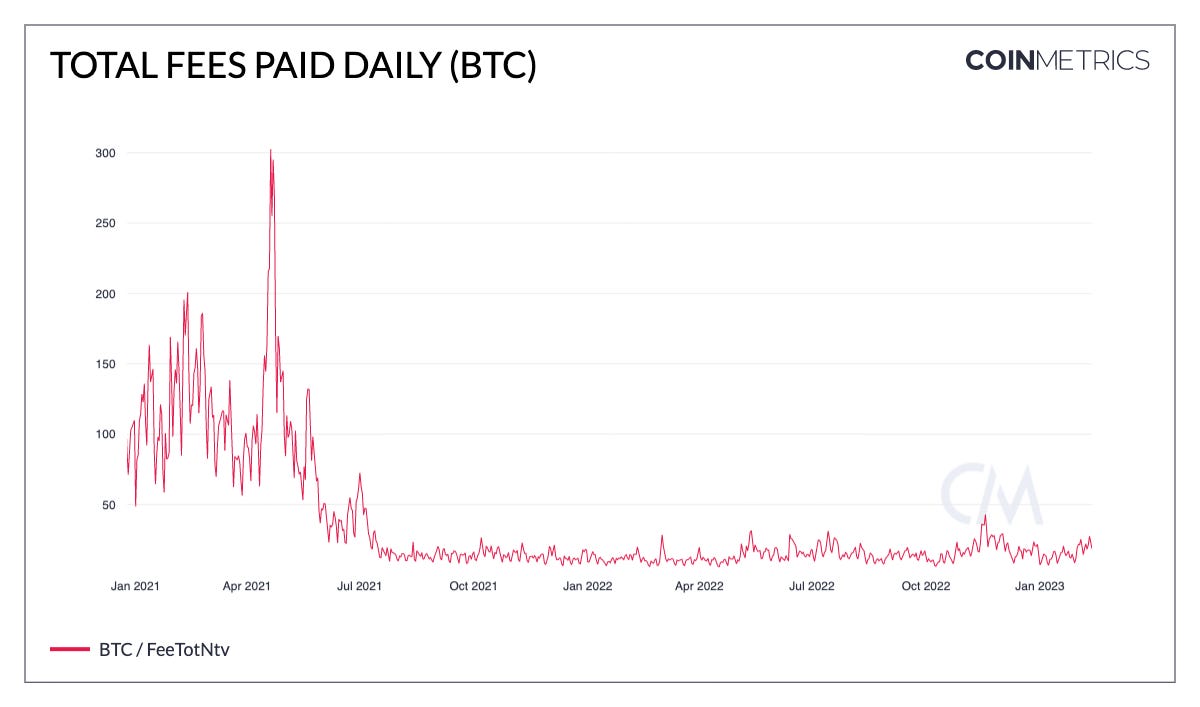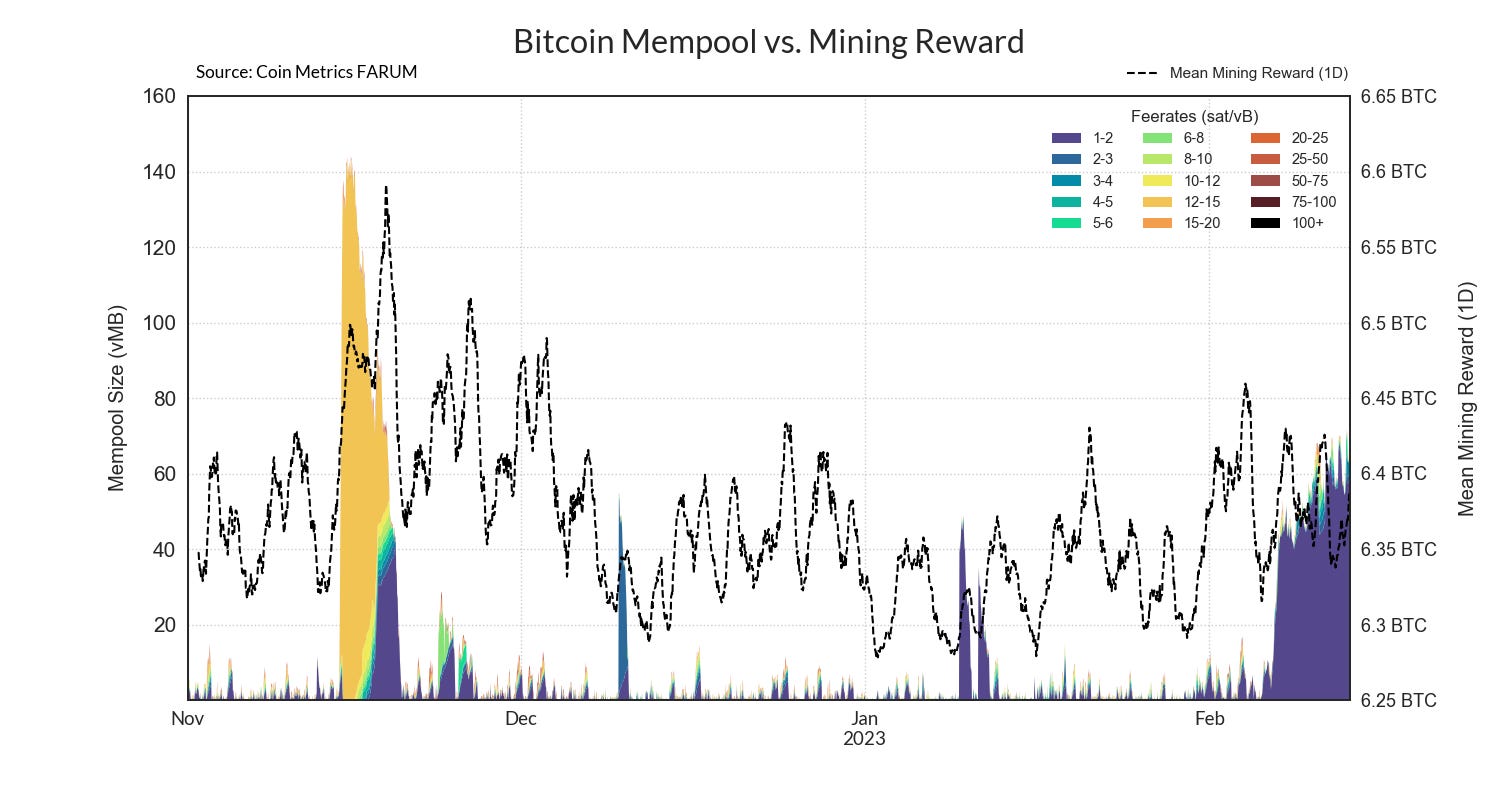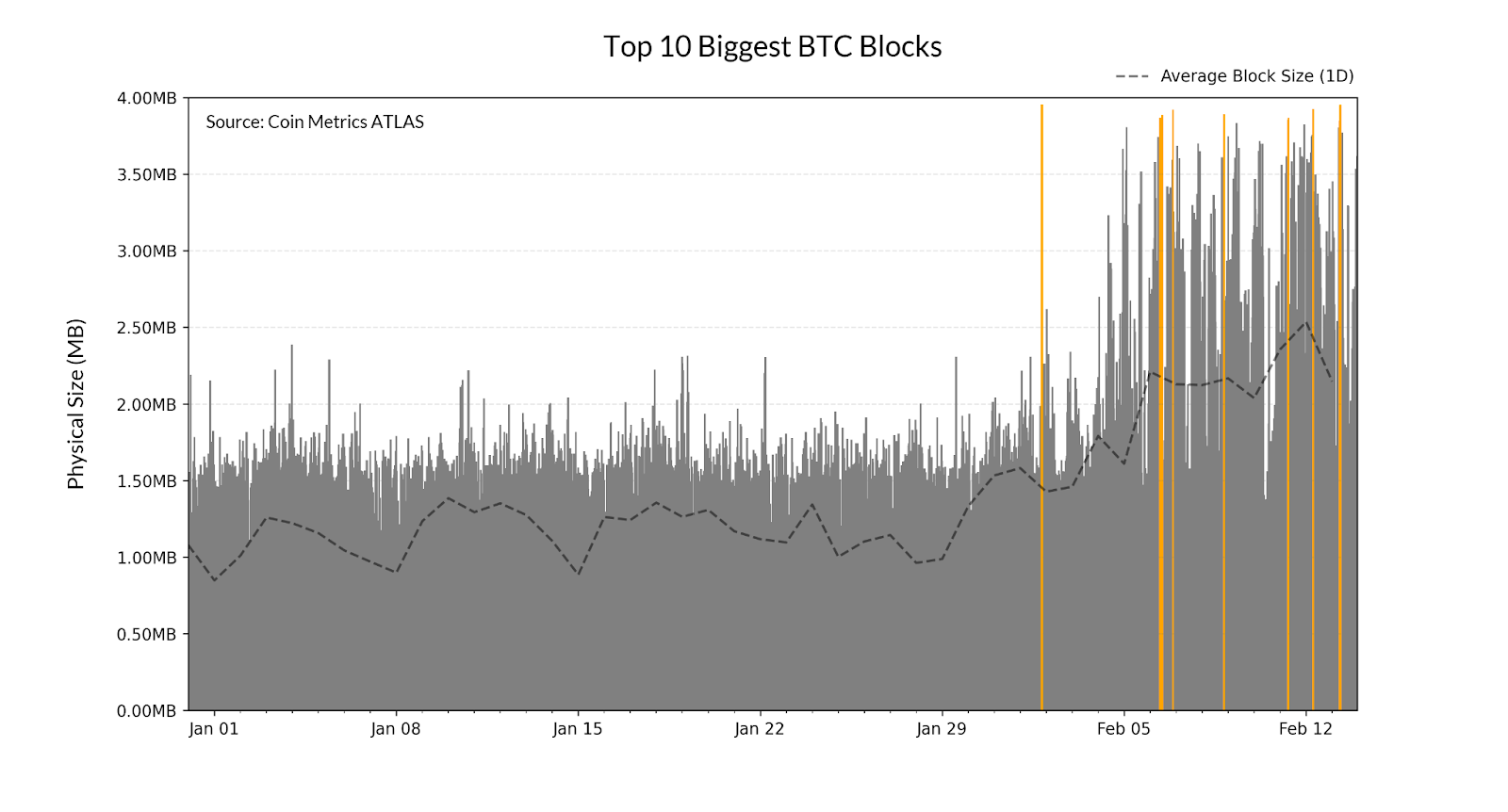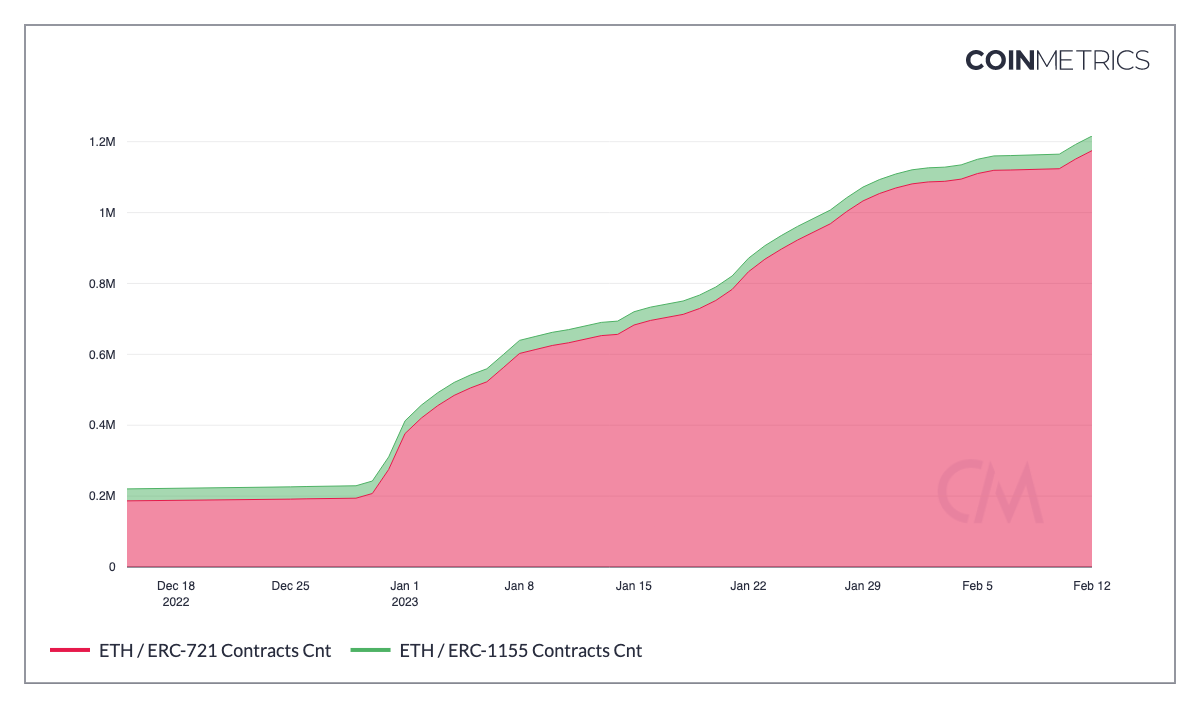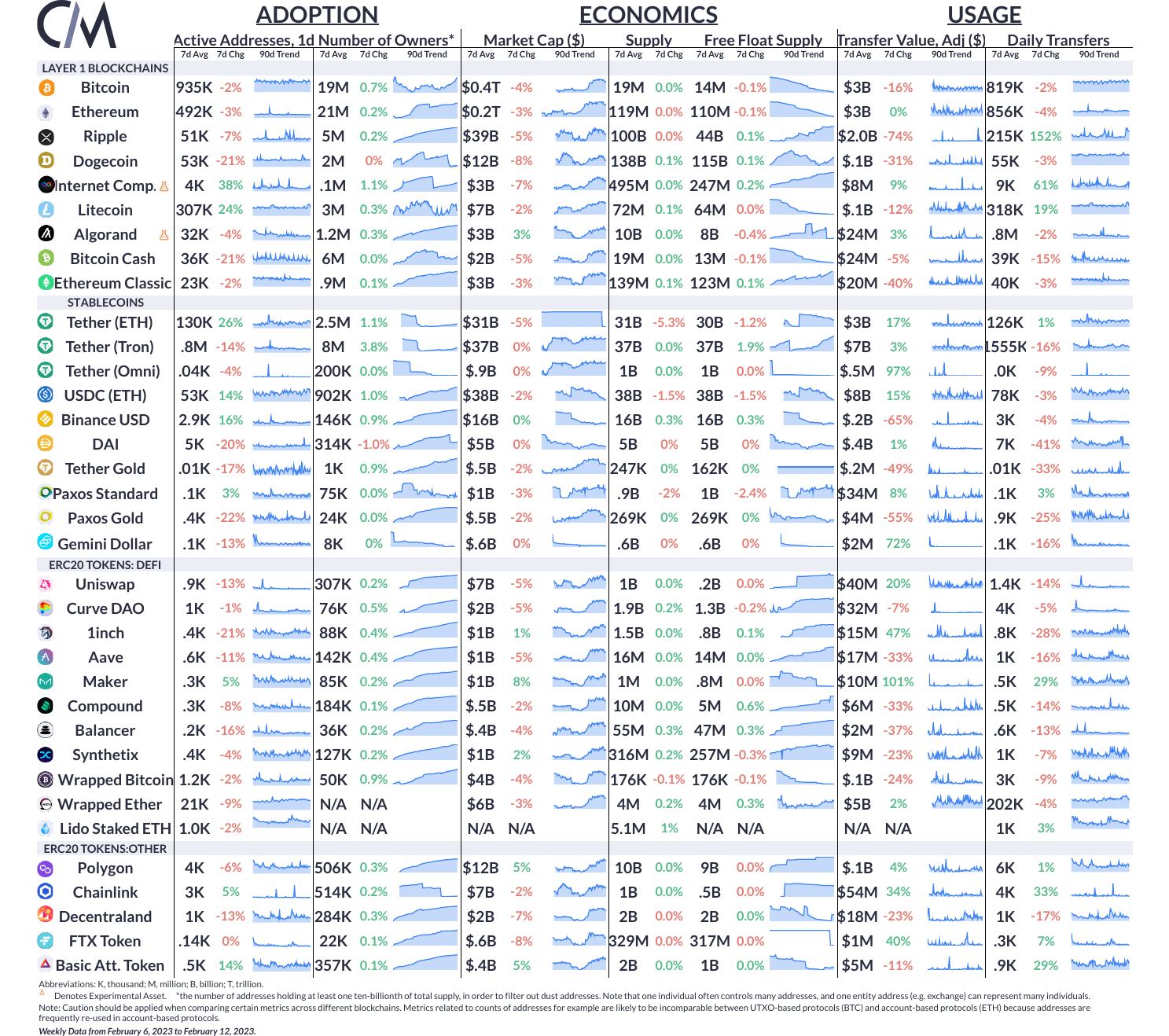Coin Metrics’ State of the Network: Issue 194
Get the best data-drive crypto insights and analysis every week: No Ordinary NumberBy: The Coin Metrics Team Bitcoin’s nature is inextricably linked to the philosophy that guided its design and development. It is, first and foremost, a philosophy that aims to maximize the power of the individual to own and control their assets and identity through cryptography. It also enshrines money as a public good—beyond state control—subject to purely mechanical and predetermined issuance. The notion of immutability in protocol design, transaction finality, and issuance schedule, is firmly anchored by both the design and the community of people participating and making use of the network. It is thus astonishing to witness a novel use case for Bitcoin emerge so suddenly, as is the case with Ordinals. What is an ordinal?Ordinal numbers are a mathematical concept that extends the set of natural numbers (1, 2, 3, …) to include a notion of order. If we consider satoshis (sats) the elementary particles of Bitcoin—that is, the smallest, indivisible constituent elements—we can define a mapping between sats and ordinals by naturally counting the order in which these sats were minted. Mathematically, we can say that the set of satoshis is well-ordered because there exists an unambiguous and well-defined mapping between the order in which these sats were minted (ordered and recorded in the Bitcoin chain) and the set of natural numbers that we use to count them. This mapping is possible because, while the exchange value of BTC applies equally to all satoshis, the identity of each satoshi is uniquely determined by the blockchain record—making each satoshi non-fungible insofar as each satoshi is perfectly distinct and differentiable from every other satoshi. So while the concept of fungibility is usually centered on the exchange value of an asset, the perfect (i.e., complete, unique) history of every satoshi, from the moment it’s minted, across every transaction, allows us to postulate an identity for each satoshi—an identity that may in turn affect the exchange value. It is not, however, the only way of categorizing satoshis, as other equally-valid numbering systems can be implemented, such as FIFO vs LIFO. Ordering sats naturally leads to multiple interpretations of a sat’s relative rarity and value in relation to the 1.9 quadrillion sats that were mined so far. We can thus consider the first satoshi minted in a block to be much rarer than the average satoshi, as there are ~776,400 blocks in total. We can go further and identify the first satoshi in a difficulty adjustment, which happens every two weeks (~242 difficulty adjustments in total), or even the first satoshi minted after a halving, which happens every four years (3 halvings so far), to identify unbelievably rare sats. However, this system of attribution is entirely arbitrary, so other means of ascribing rarity to sats may ultimately become more dominant than the system described previously, based on sat issuance. Other schemes that define names, numbers, coordinates, percentiles, etc. based on sat order can be just as easily considered. What is an inscription?Inscriptions are a type of digital collectible or artifact that is created using taproot script-path spend scripts. Inscriptions are stored entirely on-chain—a change facilitated by the Taproot upgrade, since taproot scripts have fewer restrictions than those found on traditional OP_RETURN messages. This upgrade greatly expanded the limit on storage available to Bitcoin users, from a measly 80 bytes to the full-block 4 MB, an increase of 50,000x over the previous limit. This blockspace can be filled with any data or media, including text, images, videos, the game of Snake, and more. These are very similar to the NFTs that people have become accustomed to, with a critical distinction that these “NFTs” must be minted and stored on-chain one-by-one. Following the SegWit upgrade, the Bitcoin protocol allowed users to pay less in fees for the witness data associated with a SegWit transaction. This operation reduced the price of an average transaction and encouraged the spending of a greater set of inputs to disincentivize the “splitting” of UTXOs. Furthermore, the witness data does not need to be stored once the transaction has been verified and spent, allowing nodes to prune this data once fully synced. Following the Taproot upgrade, this witness data “discount” was available to be used by inscriptions, which are stored in the witness data field. This witness discount helps to make the process of creating inscriptions more economical than other means of storing data on-chain, especially in relation to regular economic transactions. There has been a noticeable increase in Taproot usage as a direct result of demand for Ordinals, as seen in the chart above . Nevertheless, confusion and controversy flourish around ordinals’ use of Taproot. While ordinals are implemented as Pay-to-Taproot (P2TR) transactions, they do not make use of Taproot’s core innovation. Rather, they leverage a loosening of rules introduced along with Taproot to embed arbitrary data into a transaction’s signature field (known as the transaction’s witness). This change effectively removed the previous data cap for signature data. While the specific reason behind this choice remains unclear, it is likely that Bitcoin Core developers were considering things like Zero Knowledge Proofs, which are larger in size, to be embedded in Bitcoin transactions. Although this might have been the initial justification, it was instead cleverly used by ordinals to embed all sorts of data into the blockchain. Stuffing the MempoolThe continued weakness of the Bitcoin fee market in the face of an inevitable decline in block subsidies has sparked some concern around the network’s ability to properly incentivize miners in the future. Therefore, the introduction of a new source of demand for Bitcoin transactions—beyond simple transfers—has the potential to provide a welcomed boost in fees. However, despite the busy mempool (the virtual queue of transactions waiting to be included in a block) and recent interest around ordinals, on-chain data is yet to show a substantial increase in the total fees paid out to miners. Source: Coin Metrics’ Network Data There are a few possible reasons for the lack of sustained pressure on the fee market so far. First, there simply might not be enough ordinals yet to make a substantial impact. Another possibility is that a portion of the fees are being paid “out-of-band”, or off-chain, directly to miners; as was the case with the largest Bitcoin block ever produced at height 774628—even though this block is hardly representative. Finally, fees might not be rising yet due to the structural composition of the mempool. As mentioned earlier, the witness data “discount” effectively allows more space to be taken up at a lower fee rate. But as the mempool continues to fill up, lower bound transactions at a fee rate of 1 sat/vB have started crowding the mempool to the point where transactors may need to start raising rates to stay competitive. On-Chain ImpactIt has been little over two weeks since the use of inscriptions began taking off, but already we can find many significant changes across our network data. The sum block size per day (in MB) has swelled to over 400 MB added to the chain daily, including all witness data. Source: Coin Metrics’ Network Data The increased size of blocks has some implications for node operators, but is not as much of a burden as one might anticipate at first glance. Although Witness data must be downloaded during initial synchronization of the Bitcoin blockchain (a node “sync”), it can be purged once this node syncing is completed. However, this can cause issues if too many nodes purge this data, making it harder for a prospective node operator to locate a network peer with the full history of transaction signatures, even if they planned to prune it afterwards themselves. Nonetheless, the impact of these recent developments is clearly visible in the distribution of Bitcoin’s largest blocks in history, which were all mined over the last two weeks. Although this is a relatively new development in Bitcoin’s history, some of these new dynamics are likely to persist in the form of structurally heavier blocks. Longer-Term Impacts?Bitcoin is not the only blockchain facing a drastic increase in NFT issuance. The number of NFT smart contracts in Ethereum has increased nearly five fold thus far this year. In Ethereum, one of the culprits behind this trend appears to be a project called XEN which is aggressively air-dropping NFTs compliant with the ERC721 standard to existing addresses. The less drastic growth in contracts compliant with ERC1155, the second most popular NFT standard, indicates a unilateral growth in NFT issuance. Source: Coin Metrics’ Network Data Pro The recent increase in NFT issuance might be due to the precedent set by previous bull markets. Consider this: the first Cryptopunk was issued in a period of low fees, the summer of 2017, where average transaction fees hovered between 20 and 30 cents. NFTs take time to accrue value, so it makes sense to issue them in times of low demand for block space, when transaction fees are low, thereby enabling NFT creators to issue tokens more trivially. In contrast to the many NFT marketplaces on Ethereum, Solana, and smart contract platforms in general, the Ordinals ecosystem is so young that it still lacks marketplace infrastructure for trading. Some users have resorted to tracking sales off-chain on forums, while new ordinals are shared primarily on social media. One might argue Ordinal NFTs carry features of a grassroots movement. It is no coincidence then that some inscriptions explore themes that take Bitcoiners back to the early days of Bitcoin itself. ConclusionAlthough inscriptions and ordinals are novel concepts for most, they are not by any means the first NFT or “digital artifact” that has been explored on the Bitcoin network. However, they are having a measurable impact on-chain, and may have a better chance at catching on and perhaps contributing to Bitcoin’s security budget as issuance diminishes over time. It is exciting to witness how creative developers eke out new functionality out of existing infrastructure, and we cannot wait to see what new surprises remain barely out of hand’s reach—just waiting for a clever hacker or a driven team of developers to bring it to reality. Network Data InsightsSummary MetricsSource: Coin Metrics Network Data Pro Bitcoin active addresses fell 2% over the week, while Ethereum active addresses also fell by about 3%. Tether activity rose sharply on Ethereum, with daily active addresses averaging 130K, a 26% rise over the previous week. Coin Metrics UpdatesThis week’s updates from the Coin Metrics team:
As always, if you have any feedback or requests please let us know here. Subscribe and Past IssuesCoin Metrics’ State of the Network, is an unbiased, weekly view of the crypto market informed by our own network (on-chain) and market data. If you'd like to get State of the Network in your inbox, please subscribe here. You can see previous issues of State of the Network here. To learn more, acquire our data, or contact Coin Metrics, reach out here. © 2023 Coin Metrics Inc. All rights reserved. Redistribution is not permitted without consent. This newsletter does not constitute investment advice and is for informational purposes only and you should not make an investment decision on the basis of this information. The newsletter is provided “as is” and Coin Metrics will not be liable for any loss or damage resulting from information obtained from the newsletter. |
Older messages
Coin Metrics’ State of the Network: Issue 193
Tuesday, February 7, 2023
Tuesday, February 7th, 2023
[Report] Coin Metrics' State of the Network: Issue 192
Tuesday, January 31, 2023
Tuesday, January 31st, 2023
Coin Metrics’ State of the Network: Issue 191
Tuesday, January 24, 2023
Tuesday, January 24th, 2023
Coin Metrics’ State of the Network: Issue 190
Friday, January 20, 2023
Wednesday, January 18th, 2023
Coin Metrics’ State of the Network: Issue 189
Tuesday, January 10, 2023
Tuesday, January 10th, 2023
You Might Also Like
Central African Republic’s CAR memecoin raises scrutiny
Friday, February 14, 2025
Allegations of deepfake videos and opaque token distribution cast doubts on CAR's ambitious memecoin project. ͏ ͏ ͏ ͏ ͏ ͏ ͏ ͏ ͏ ͏ ͏ ͏ ͏ ͏ ͏ ͏ ͏ ͏ ͏ ͏ ͏ ͏ ͏ ͏ ͏ ͏ ͏ ͏ ͏ ͏ ͏ ͏ ͏ ͏ ͏ ͏ ͏ ͏ ͏ ͏ ͏ ͏ ͏ ͏
January CEX Data Report: Significant Declines in Trading Volume Across Major CEXs, Spot Down 25%, Derivatives Down…
Friday, February 14, 2025
According to data collected by the WuBlockchain team, spot trading volume on major central exchanges in January 2025 decreased by 25% compared to December 2024. ͏ ͏ ͏ ͏ ͏ ͏ ͏ ͏ ͏ ͏ ͏ ͏ ͏ ͏ ͏ ͏ ͏ ͏ ͏ ͏
Previewing Coinbase Q4 2024 Earnings
Friday, February 14, 2025
Estimating Coinbase's Transaction and Subscriptions & Services Revenue in Q4 2024 ͏ ͏ ͏ ͏ ͏ ͏ ͏ ͏ ͏ ͏ ͏ ͏ ͏ ͏ ͏ ͏ ͏ ͏ ͏ ͏ ͏ ͏ ͏ ͏ ͏ ͏ ͏ ͏ ͏ ͏ ͏ ͏ ͏ ͏ ͏ ͏ ͏ ͏ ͏ ͏ ͏ ͏ ͏ ͏ ͏ ͏ ͏ ͏ ͏ ͏ ͏ ͏ ͏ ͏ ͏ ͏
ADA outperforms Bitcoin as Grayscale seeks approval for first US Cardano ETF in SEC filing
Friday, February 14, 2025
Grayscale's Cardano ETF filing could reshape ADA's market position amid regulatory uncertainty ͏ ͏ ͏ ͏ ͏ ͏ ͏ ͏ ͏ ͏ ͏ ͏ ͏ ͏ ͏ ͏ ͏ ͏ ͏ ͏ ͏ ͏ ͏ ͏ ͏ ͏ ͏ ͏ ͏ ͏ ͏ ͏ ͏ ͏ ͏ ͏ ͏ ͏ ͏ ͏ ͏ ͏ ͏ ͏ ͏ ͏ ͏ ͏ ͏
AI project trading tips: investment targets and position management
Friday, February 14, 2025
This interview delves into the investment trends, market landscape, and future opportunities within AI Agent projects. ͏ ͏ ͏ ͏ ͏ ͏ ͏ ͏ ͏ ͏ ͏ ͏ ͏ ͏ ͏ ͏ ͏ ͏ ͏ ͏ ͏ ͏ ͏ ͏ ͏ ͏ ͏ ͏ ͏ ͏ ͏ ͏ ͏ ͏ ͏ ͏ ͏ ͏ ͏ ͏ ͏
DeFi & L1L2 Weekly — 📈 Polymarket recorded a new high of 462.6k active users in Jan despite volume dip; Holesky a…
Friday, February 14, 2025
Polymarket recorded a new high of 462600 active users in January despite volume dip; Holesky and Sepolia testnets are scheduled to fork in Feb and Mar for Ethereum's Pectra upgrade. ͏ ͏ ͏ ͏ ͏ ͏ ͏ ͏
DeFi & L1L2 Weekly — 📈 Polymarket recorded a new high of 462.6k active users in Jan despite volume dip; Holesky a…
Friday, February 14, 2025
Polymarket recorded a new high of 462600 active users in January despite volume dip; Holesky and Sepolia testnets are scheduled to fork in Feb and Mar for Ethereum's Pectra upgrade. ͏ ͏ ͏ ͏ ͏ ͏ ͏ ͏
Donald Trump taps crypto advocate a16z’s Brian Quintenz for CFTC leadership
Friday, February 14, 2025
Industry leaders back Brian Quintenz's nomination, highlighting his past efforts at the CFTC and potential to revamp crypto oversight. ͏ ͏ ͏ ͏ ͏ ͏ ͏ ͏ ͏ ͏ ͏ ͏ ͏ ͏ ͏ ͏ ͏ ͏ ͏ ͏ ͏ ͏ ͏ ͏ ͏ ͏ ͏ ͏ ͏ ͏ ͏
⚡10 Tips to Make a Living Selling Info Products
Friday, February 14, 2025
PLUS: the best links, events, and jokes of the week → ͏ ͏ ͏ ͏ ͏ ͏ ͏ ͏ ͏ ͏ ͏ ͏ ͏ ͏ ͏ ͏ ͏ ͏ ͏ ͏ ͏ ͏ ͏ ͏ ͏ ͏ ͏ ͏ ͏ ͏ ͏ ͏ ͏ ͏ ͏ ͏ ͏ ͏ ͏ ͏ ͏ ͏ ͏ ͏ ͏ ͏ ͏ ͏ ͏ ͏ ͏ ͏ ͏ ͏ ͏ ͏ ͏ ͏ ͏ ͏ ͏ ͏ ͏ ͏ ͏ ͏ ͏ ͏ ͏ ͏ ͏ ͏ ͏ ͏
Interview with CryptoD: How He Made $17 Million Profit on TRUMP Coin
Friday, February 14, 2025
Author | WUblockchain, Foresight News ͏ ͏ ͏ ͏ ͏ ͏ ͏ ͏ ͏ ͏ ͏ ͏ ͏ ͏ ͏ ͏ ͏ ͏ ͏ ͏ ͏ ͏ ͏ ͏ ͏ ͏ ͏ ͏ ͏ ͏ ͏ ͏ ͏ ͏ ͏ ͏ ͏ ͏ ͏ ͏ ͏ ͏ ͏ ͏ ͏ ͏ ͏ ͏ ͏ ͏ ͏ ͏ ͏ ͏ ͏ ͏ ͏ ͏ ͏ ͏ ͏ ͏ ͏ ͏ ͏ ͏ ͏ ͏ ͏ ͏ ͏ ͏ ͏ ͏ ͏ ͏ ͏ ͏ ͏ ͏ ͏ ͏
